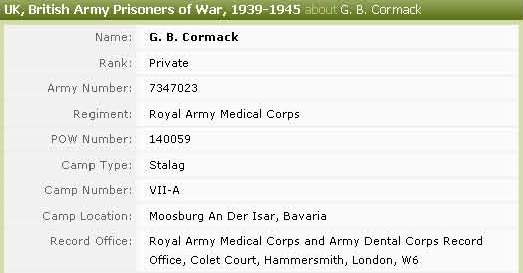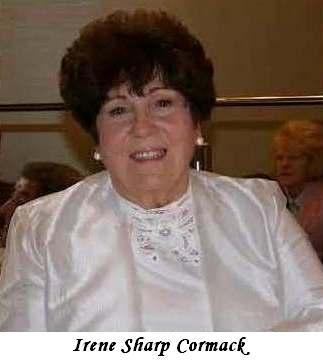|
George Burnett Cormack (June
19, 1921- June 24, 1999)

The names Cormack and
Sharp, appearing on billboards outside variety theatres and in hotel
cabaret, guaranteed a popular, high-quality musical twosome in Scotland,
England, and Ireland, for close on three decades. That was the rule from
the 1950s through to the 70s, when live variety and popular Scottish
revue flourished from Aberdeen and Inverness all the way down to most of
Scotland's central belt.
George Burnett Cormack
and Irene Stewart Sharp were an intrinsic part of that popular
entertainment heritage. George and his lovely brunette partner and wife
Irene, a Glasgow lass who could easily have doubled for the film actress
Elizabeth Taylor, became favourites with a wide audience of theatregoers
all the way from George's native Aberdeen to summer shows in Eastbourne
and Llandudno, and then across the Atlantic to American cities like
Detroit, New York, and San Francisco. Audiences applauded them on their
busy and widespread theatrical touring.
But only a few of their admirers knew George's wartime secret - how,
after apprenticeship as a stonemason in Aberdeen, he had joined the
Territorial Army and flown on active service with the medical corps,
parachuting against all the risks and dangers into Arnhem where he
stayed behind to tend the wounded. This meant capture and retention in a
prison camp; it was here that he used his singing talents to advantage
in musical and band shows, raising the spirits of fellow PoWs with many
a stirring Scottish tune. His picture in wartime uniform is held today
in the Airborne Museum, commemorating those deeds of valour that make
Arnhem a place-name linked for all time with bravery in air-landing
combat.

The Hitler war over,
George went professional as a singer, winning spots in the many variety
theatres then flourishing in Scotland. He joined the Lex McLean show at
the little Palladium Theatre in Edinburgh's Fountainbridge, a nursery
for so many showbiz aspirants, and found himself on the same bill as
bright-eyed Irene Sharp from Glasgow's Lambhill. They compared singing
notes, fell in love, then decided to form a double act and get married.
They 'tied the knot' in Dunblane and Lecropt in 1952 to become one of
the happiest of twosomes both offstage and on.
For some years they were
regular artists on the handsome luxury Cunard liners criss-crossing the
Atlantic, entertaining sophisticated travellers in pre-airliner days
with songs from an international as well as a truly Scottish repertoire.
It was an era when stars from Hollywood and Broadway took ships, not
aeroplanes, to ferry them between stage and screen jobs in Britain and
North America. George Cormack taught Spencer Tracey to sing ‘The Brig o'
Balgownie’,
02GeorgeCormackIreneSharpTheBrigOBalgownie.wav
and persuaded his good
friend and fellow-traveller Katharine Hepburn to learn the correct
lyrics of Loch Lomond. Rex Harrison, bound to and from Broadway, was
another theatrical admirer, one of a procession of thespian voyagers
relaxing as audience members in a refreshing style of mid-Atlantic
cabaret featuring songs from Scotland, all the more appropriate since it
was being staged on a Clyde-built ship. The Queen Mary and Queen
Elizabeth liners became almost a second home to the Scots twosome.
Later, they sailed on cruise ships around South America and to South
Africa, George introducing the act in that wholesome and friendly
Aberdeen accent he never lost.
Illness dogged Cormack in
his latter years, but he was able to appreciate and enjoy family toasts
to his 78th birthday before going into hospital where he died from a
severe heart attack five days later. He was survived by his wife Irene,
daughter Lee-Anne, son-in-law Duncan, and a two-and-a-half-year-old
grandson Adam, as well as by his four sisters in Aberdeen.

On Sunday the 12th of
April, 2009 within the Glasgow Royal Concert Hall, the Scottish Music
Hall and Variety Theatre Society honoured Irene (Sharp) Cormack. Irene
who is a Glaswegian had, on stage, a gloriously penetrating, yet sweet
voice, whether she was singing traditional Scots songs or excerpts from
operettas. George on the other hand had a fairly soft voice, but he was
versatile enough to blend well in close harmony with Irene to produce
what came to be known as the unique Cormack and Sharp sound.
[Information based on an
obituary printed in the Glasgow Herald on 26th June, 1999, a report of
the SMHVTS function in April 2009, and GRO and MOD images]
04GeorgeCormackIreneSharpTheWildMountainThyme.wav
05GeorgeCormackIreneSharpAPerfectDay.wav |

